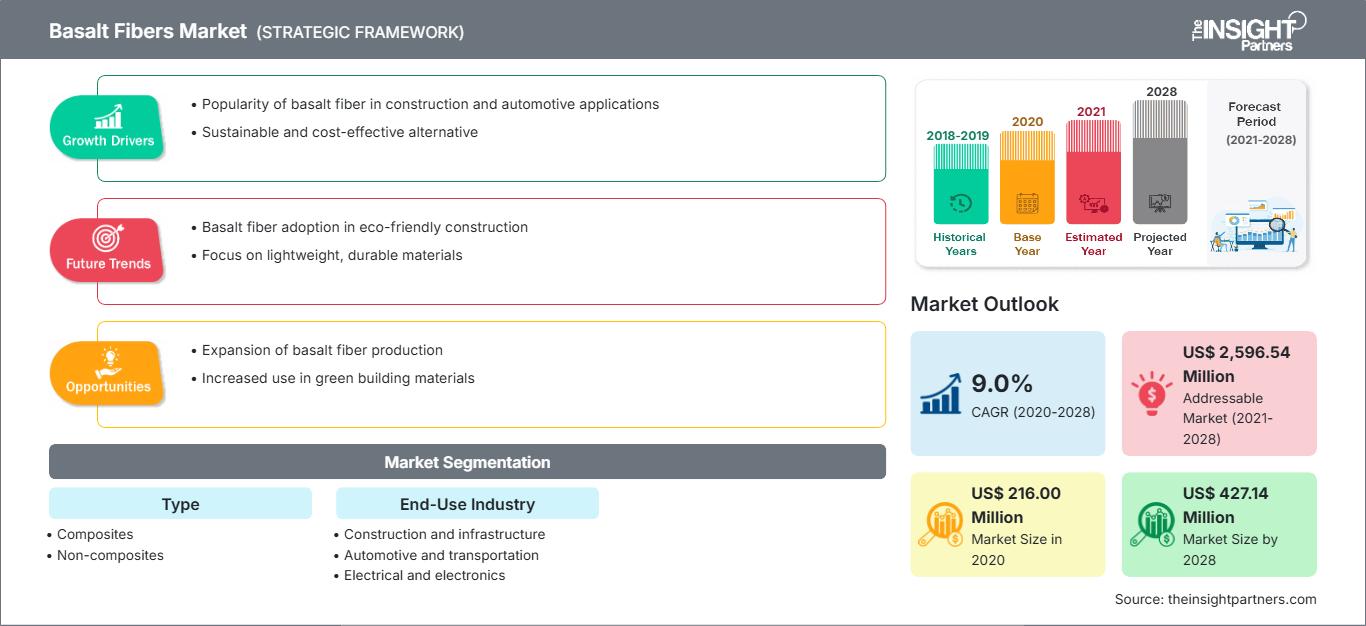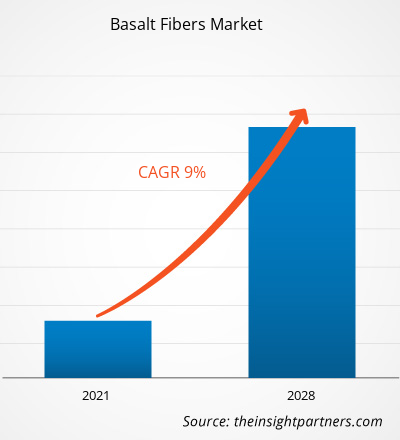Der Markt für Basaltfasern wurde im Jahr 2020 auf 216,00 Millionen US-Dollar geschätzt und soll bis 2028 427,14 Millionen US-Dollar erreichen; von 2021 bis 2028 wird eine durchschnittliche jährliche Wachstumsrate (CAGR) von 9,0 % erwartet.
Basaltfasern besitzen ähnliche chemische Eigenschaften wie Glasfasern, weisen jedoch bessere physikochemischen Eigenschaften auf. Aufgrund der Nachfrage aus Endverbrauchsbranchen wie der Automobil-, Schifffahrts-, Bau- und Elektronikindustrie wird für den Basaltfasermarkt ein starkes Wachstum erwartet. Zunehmende Bautätigkeiten in mehreren Regionen aufgrund von Bevölkerungswachstum, steigenden Einkommen und staatlichen Initiativen in verschiedenen Volkswirtschaften zur Entwicklung einer besseren Infrastruktur werden das Wachstum des Basaltfasermarktes voraussichtlich ankurbeln. Die inkonsistenten Rohstoffeigenschaften zählen jedoch zu den Faktoren, die das Wachstum des Basaltfasermarktes hemmen.
Im Jahr 2020 entfiel der größte Anteil des globalen Basaltfasermarktes auf den asiatisch-pazifischen Raum. Der asiatisch-pazifische Kontinent umfasst mehrere Entwicklungs- und Industrieländer wie Indien, China, Japan, Südkorea und Australien. In den Schwellenländern ist ein Aufschwung der Industrialisierung und Urbanisierung zu verzeichnen. Das Wachstum von Bauprojekten in Ländern wie Indien und China und steigende Investitionen in Infrastrukturmaßnahmen wie den Neubau von Autobahnen, Eisenbahnen, U-Bahn-Linien und Straßenbelägen dürften den Basaltfasermarkt in der Region stärken.
Passen Sie diesen Bericht Ihren Anforderungen an
Sie erhalten kostenlos Anpassungen an jedem Bericht, einschließlich Teilen dieses Berichts oder einer Analyse auf Länderebene, eines Excel-Datenpakets sowie tolle Angebote und Rabatte für Start-ups und Universitäten.
Markt für Basaltfasern: Strategische Einblicke

-
Holen Sie sich die wichtigsten Markttrends aus diesem Bericht.Dieses KOSTENLOSE Beispiel umfasst Datenanalysen, die von Markttrends bis hin zu Schätzungen und Prognosen reichen.
Auswirkungen der COVID-19-Pandemie auf den Basaltfasermarkt
Die anhaltende Pandemie hat den Status des Chemie- und Werkstoffsektors drastisch verändert und das Wachstum des Basaltfasermarktes negativ beeinflusst.
Die Umsetzung von Maßnahmen zur Eindämmung der Virusausbreitung hat das Wachstum mehrerer Industriezweige beeinträchtigt. Branchen wie Bau, Automobil, Chemie und Elektronik sind von der plötzlichen Verzerrung der Betriebseffizienz und Störungen der Wertschöpfungsketten infolge der plötzlichen Schließung nationaler und internationaler Grenzen betroffen. Der deutliche Wachstumsrückgang mehrerer Industriezweige hatte schwerwiegende Auswirkungen auf die Nachfrage nach Basaltfasern auf dem Weltmarkt. Da die Volkswirtschaften jedoch eine Wiederbelebung ihrer Aktivitäten planen, wird erwartet, dass die Nachfrage nach Basaltfasern weltweit steigen wird. Die steigende Nachfrage nach Basaltfasern in verschiedenen Branchen wie Bauwesen, Automobilindustrie, Chemie, Elektronik und Luft- und Raumfahrt sowie erhebliche Investitionen namhafter Hersteller dürften das Wachstum für Basaltfasern vorantreiben.Markteinblicke: Breite Anwendungsmöglichkeiten von Basaltfasern in verschiedenen Endverbrauchsbranchen treiben das Marktwachstum voran
Basaltfasern haben ein breites Anwendungsspektrum in verschiedenen Endverbrauchsbranchen wie Bauwesen, Automobilindustrie, Elektro- und Elektronikindustrie, Chemie, Luft- und Raumfahrt und Schifffahrt. Im Bauwesen werden geschnittene Basaltstränge verwendet, um die Rissbeständigkeit von Zementplatten zu erhöhen. Aufgrund der einzigartigen chemischen Stabilität von Basaltfasern unter extremen Bedingungen können sie in vielen Betonkonstruktionen wie Brücken, Tunneln, Dämmen und Böden verwendet werden. Basaltfasern werden in der chemischen Industrie zur Herstellung von chemikalienbeständigen Rohren, Schutzbeschichtungen, Lagertanks für ätzende Flüssigkeiten, chemische Düngemittel, Säuren, giftige Substanzen usw. verwendet. Da die Anwendung von Basaltfasern immer weiter zunimmt, steigt auch die Marktnachfrage nach Basaltfasern immer schneller.Produkteinblicke
Basierend auf dem Produkt ist der globale Basaltfasermarkt in Roving, Kurzfaser, Zwirn, Gewebe und Bänder und Sonstiges unterteilt. Das Roving-Segment hatte 2020 den größten Anteil am globalen Basaltfasermarkt. Basaltroving ist ein Bündel aus endlosen, unidirektionalen, komplexen Basaltfasern. Roving ist beständig gegen aggressive Umgebungen, hat eine hohe natürliche Festigkeit, eine lange Lebensdauer und hervorragende elektrische Isoliereigenschaften. Aufgrund seiner technischen Eigenschaften übertrifft Basaltroving E-Glas und S-Glas in vielerlei Hinsicht. Basaltroving ist extrem hitzebeständig und kann kurzzeitig Temperaturen von bis zu 1.000 °C standhalten.
Kamenny Vek Company; Fiberbas Construction and Building Technologies; Hydro Design Management Co. Pvt. Ltd.; Hg Gbf Basalt Fiber Co., Ltd; Bastech; Mafic SA; Shanxi Basalt Fiber Technology Co. Ltd; Technobasalt-Invest LLC; Deutsche Basalt Faser Gmbh; und Basalt Engineering LLC gehören zu den wichtigsten Akteuren auf dem globalen Basaltfasermarkt.
Berichts-Spotlights
- Fortschreitende Branchentrends auf dem Basaltfasermarkt helfen den Akteuren bei der Entwicklung effektiver langfristiger Strategien
- Geschäftswachstumsstrategien in entwickelten und sich entwickelnden Märkten
- Quantitative Analyse des Basaltfasermarktes von 2019 bis 2028
- Schätzung der weltweiten Nachfrage nach Basaltfasern
- PEST-Analyse zur Veranschaulichung der Wirksamkeit von Käufern und Lieferanten in der Branche
- Jüngste Entwicklungen zum Verständnis des wettbewerbsorientierten Marktszenarios
- Markttrends und -aussichten sowie Faktoren, die das Wachstum des Basaltfasermarktes vorantreiben und hemmen
- Unterstützung im Entscheidungsprozess durch Hervorhebung von Marktstrategien, die das kommerzielle Interesse untermauern und zum Marktwachstum führen
- Die Größe des Basaltfasermarktes bei verschiedene Knotenpunkte
- Detaillierter Überblick und Segmentierung des Marktes sowie der Dynamik der Basaltfaserindustrie
- Größe des Basaltfasermarktes in verschiedenen Regionen mit vielversprechenden Wachstumschancen
Basaltfasern
Regionale Einblicke in den BasaltfasermarktDie Analysten von The Insight Partners haben die regionalen Trends und Faktoren, die den Basaltfasermarkt im Prognosezeitraum beeinflussen, ausführlich erläutert. In diesem Abschnitt werden auch die Marktsegmente und die geografische Lage in Nordamerika, Europa, dem asiatisch-pazifischen Raum, dem Nahen Osten und Afrika sowie Süd- und Mittelamerika erörtert.
Umfang des Marktberichts zu Basaltfasern
| Berichtsattribut | Einzelheiten |
|---|---|
| Marktgröße in 2020 | US$ 216.00 Million |
| Marktgröße nach 2028 | US$ 427.14 Million |
| Globale CAGR (2020 - 2028) | 9.0% |
| Historische Daten | 2018-2019 |
| Prognosezeitraum | 2021-2028 |
| Abgedeckte Segmente |
By Typ
|
| Abgedeckte Regionen und Länder |
Nordamerika
|
| Marktführer und wichtige Unternehmensprofile |
|
Dichte der Marktteilnehmer für Basaltfasern: Verständnis ihrer Auswirkungen auf die Geschäftsdynamik
Der Basaltfasermarkt wächst rasant. Die steigende Nachfrage der Endverbraucher ist auf Faktoren wie veränderte Verbraucherpräferenzen, technologische Fortschritte und ein stärkeres Bewusstsein für die Produktvorteile zurückzuführen. Mit der steigenden Nachfrage erweitern Unternehmen ihr Angebot, entwickeln Innovationen, um den Bedürfnissen der Verbraucher gerecht zu werden, und nutzen neue Trends, was das Marktwachstum weiter ankurbelt.

- Holen Sie sich die Markt für Basaltfasern Übersicht der wichtigsten Akteure
Globaler Basaltfasermarkt
Nach Produkt
- Roving
- Geschnittener Strang
- Gedrehtes Garn
- Stoffe und Bänder
- Andere
Nach Endverwendung Industrie
- Baugewerbe
- Automobil
- Elektrik und Elektronik
- Chemie
- Andere
Firmenprofile
- Kamenny Vek Company
- Fiberbas Construction and Building Technologies
- Hydro Design Management Co. Pvt. Ltd.
- Hg Gbf Basalt Fiber Co., Ltd
- Bastech
- Mafic SA
- Shanxi Basalt Fiber Technology Co. Ltd
- Technobasalt-Invest LLC
- Deutsche Basalt Faser Gmbh
- Basalt Engineering LLC
- Historische Analyse (2 Jahre), Basisjahr, Prognose (7 Jahre) mit CAGR
- PEST- und SWOT-Analyse
- Marktgröße Wert/Volumen – Global, Regional, Land
- Branchen- und Wettbewerbslandschaft
- Excel-Datensatz
Aktuelle Berichte
Verwandte Berichte
Erfahrungsberichte
Grund zum Kauf
- Fundierte Entscheidungsfindung
- Marktdynamik verstehen
- Wettbewerbsanalyse
- Kundeneinblicke
- Marktprognosen
- Risikominimierung
- Strategische Planung
- Investitionsbegründung
- Identifizierung neuer Märkte
- Verbesserung von Marketingstrategien
- Steigerung der Betriebseffizienz
- Anpassung an regulatorische Trends






















 Kostenlose Probe anfordern für - Markt für Basaltfasern
Kostenlose Probe anfordern für - Markt für Basaltfasern